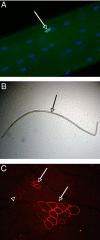Muscle hypertrophy driven by myostatin blockade does not require stem/precursor-cell activity
- PMID: 19383783
- PMCID: PMC2671322
- DOI: 10.1073/pnas.0811129106
Muscle hypertrophy driven by myostatin blockade does not require stem/precursor-cell activity
Abstract
Myostatin, a member of the TGF-beta family, has been identified as a powerful inhibitor of muscle growth. Absence or blockade of myostatin induces massive skeletal muscle hypertrophy that is widely attributed to proliferation of the population of muscle fiber-associated satellite cells that have been identified as the principle source of new muscle tissue during growth and regeneration. Postnatal blockade of myostatin has been proposed as a basis for therapeutic strategies to combat muscle loss in genetic and acquired myopathies. But this approach, according to the accepted mechanism, would raise the threat of premature exhaustion of the pool of satellite cells and eventual failure of muscle regeneration. Here, we show that hypertrophy in the absence of myostatin involves little or no input from satellite cells. Hypertrophic fibers contain no more myonuclei or satellite cells and myostatin had no significant effect on satellite cell proliferation in vitro, while expression of myostatin receptors dropped to the limits of detectability in postnatal satellite cells. Moreover, hypertrophy of dystrophic muscle arising from myostatin blockade was achieved without any apparent enhancement of contribution of myonuclei from satellite cells. These findings contradict the accepted model of myostatin-based control of size of postnatal muscle and reorient fundamental investigations away from the mechanisms that control satellite cell proliferation and toward those that increase myonuclear domain, by modulating synthesis and turnover of structural muscle fiber proteins. It predicts too that any benefits of myostatin blockade in chronic myopathies are unlikely to impose any extra stress on the satellite cells.
Conflict of interest statement
The authors declare no conflict of interest.
Figures



Similar articles
-
Role of satellite cells versus myofibers in muscle hypertrophy induced by inhibition of the myostatin/activin signaling pathway.Proc Natl Acad Sci U S A. 2012 Aug 28;109(35):E2353-60. doi: 10.1073/pnas.1206410109. Epub 2012 Aug 6. Proc Natl Acad Sci U S A. 2012. PMID: 22869749 Free PMC article.
-
Myostatin inhibition induces muscle fibre hypertrophy prior to satellite cell activation.J Physiol. 2012 May 1;590(9):2151-65. doi: 10.1113/jphysiol.2011.226001. Epub 2012 Mar 5. J Physiol. 2012. PMID: 22393251 Free PMC article.
-
Cripto regulates skeletal muscle regeneration and modulates satellite cell determination by antagonizing myostatin.Proc Natl Acad Sci U S A. 2012 Nov 20;109(47):E3231-40. doi: 10.1073/pnas.1204017109. Epub 2012 Nov 5. Proc Natl Acad Sci U S A. 2012. PMID: 23129614 Free PMC article.
-
Role of satellite cells in muscle growth and maintenance of muscle mass.Nutr Metab Cardiovasc Dis. 2013 Dec;23 Suppl 1:S12-8. doi: 10.1016/j.numecd.2012.02.002. Epub 2012 May 22. Nutr Metab Cardiovasc Dis. 2013. PMID: 22621743 Review.
-
Interference with myostatin/ActRIIB signaling as a therapeutic strategy for Duchenne muscular dystrophy.Curr Gene Ther. 2012 Jun;12(3):245-59. doi: 10.2174/156652312800840577. Curr Gene Ther. 2012. PMID: 22554312 Review.
Cited by
-
Soluble Activin Receptor Type IIB Improves Muscle Regeneration Following Crotalus atrox Venom-Induced Damage.Toxins (Basel). 2025 Jan 28;17(2):59. doi: 10.3390/toxins17020059. Toxins (Basel). 2025. PMID: 39998076 Free PMC article.
-
Antibody-directed myostatin inhibition improves diaphragm pathology in young but not adult dystrophic mdx mice.Am J Pathol. 2010 May;176(5):2425-34. doi: 10.2353/ajpath.2010.090932. Epub 2010 Apr 2. Am J Pathol. 2010. PMID: 20363926 Free PMC article.
-
Defective ATG16L1-mediated removal of IRE1α drives Crohn's disease-like ileitis.J Exp Med. 2017 Feb;214(2):401-422. doi: 10.1084/jem.20160791. Epub 2017 Jan 12. J Exp Med. 2017. PMID: 28082357 Free PMC article.
-
Skeletal muscle fibers count on nuclear numbers for growth.Semin Cell Dev Biol. 2021 Nov;119:3-10. doi: 10.1016/j.semcdb.2021.04.015. Epub 2021 May 8. Semin Cell Dev Biol. 2021. PMID: 33972174 Free PMC article. Review.
-
Cell interactome in sarcopenia during aging.J Cachexia Sarcopenia Muscle. 2022 Apr;13(2):919-931. doi: 10.1002/jcsm.12937. Epub 2022 Feb 17. J Cachexia Sarcopenia Muscle. 2022. PMID: 35178901 Free PMC article.
References
-
- McPherron AC, Lawler AM, Lee S-J. Regulation of skeletal muscle mass in mice by a new TGF-β superfamily member. Nature. 1997;387:83–90. - PubMed
-
- Bogdanovich S, et al. Functional improvement of dystrophic muscle by myostatin blockade. Nature. 2002;420:418–421. - PubMed
-
- Wagner KR, McPherron AC, Winik N, Lee SJ. Loss of myostatin attenuates severity of muscular dystrophy in mdx mice. Ann Neurol. 2002;52:832–836. - PubMed
-
- McCroskery S, et al. Improved muscle healing through enhanced regeneration and reduced fibrosis in myostatin-null mice. J Cell Sci. 2005;118:3531–3541. - PubMed
Publication types
MeSH terms
Substances
Grants and funding
LinkOut - more resources
Full Text Sources
Other Literature Sources

